Construction Technology 5 (UWS): Heat Assignment and Analysis
VerifiedAdded on 2022/11/24
|10
|1700
|370
Homework Assignment
AI Summary
This assignment solution for Construction Technology 5 explores the principles of heat transfer in building design. The student addresses questions regarding how the human body gains and loses heat through mechanisms like evaporation, radiation, convection, and conduction. The assignment then analyzes heat loss paths in an uninsulated brick veneer house in Sydney during winter, emphasizing radiation, conduction, and convection. It includes a calculation of the thermal conductance (U-value) for a cavity wall, comparing the thermal properties of different materials. Further, the solution describes cavity walls and their role in removing water and improving thermal mass. The assignment also discusses air movement, convective air movement, solar chimneys, and evaporative cooling as strategies for maintaining comfortable indoor temperatures. Finally, it examines the use of dispersed daylight and integrated systems for managing solar gain and effective illumination in buildings, including the use of louvers.
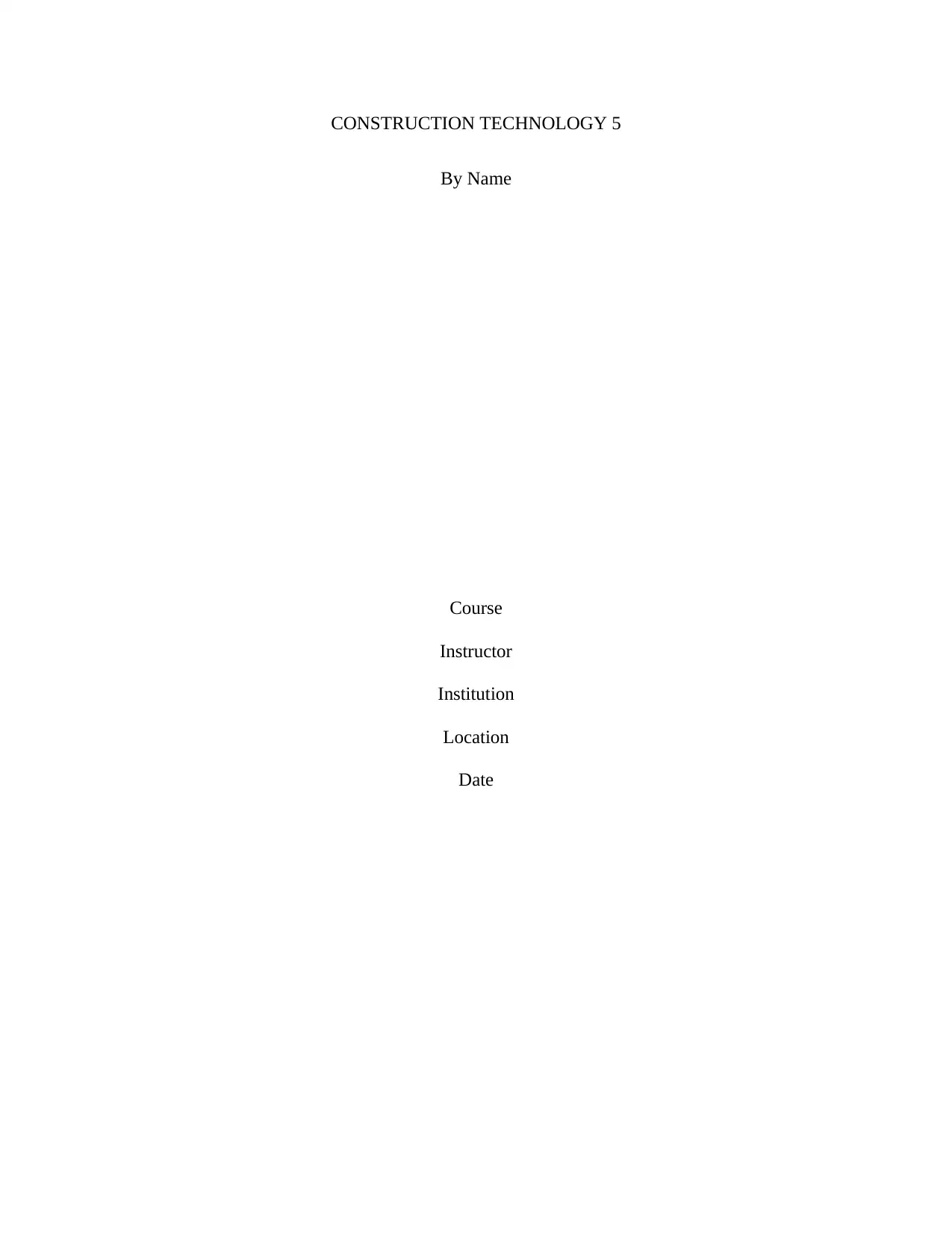
CONSTRUCTION TECHNOLOGY 5
By Name
Course
Instructor
Institution
Location
Date
By Name
Course
Instructor
Institution
Location
Date
Paraphrase This Document
Need a fresh take? Get an instant paraphrase of this document with our AI Paraphraser
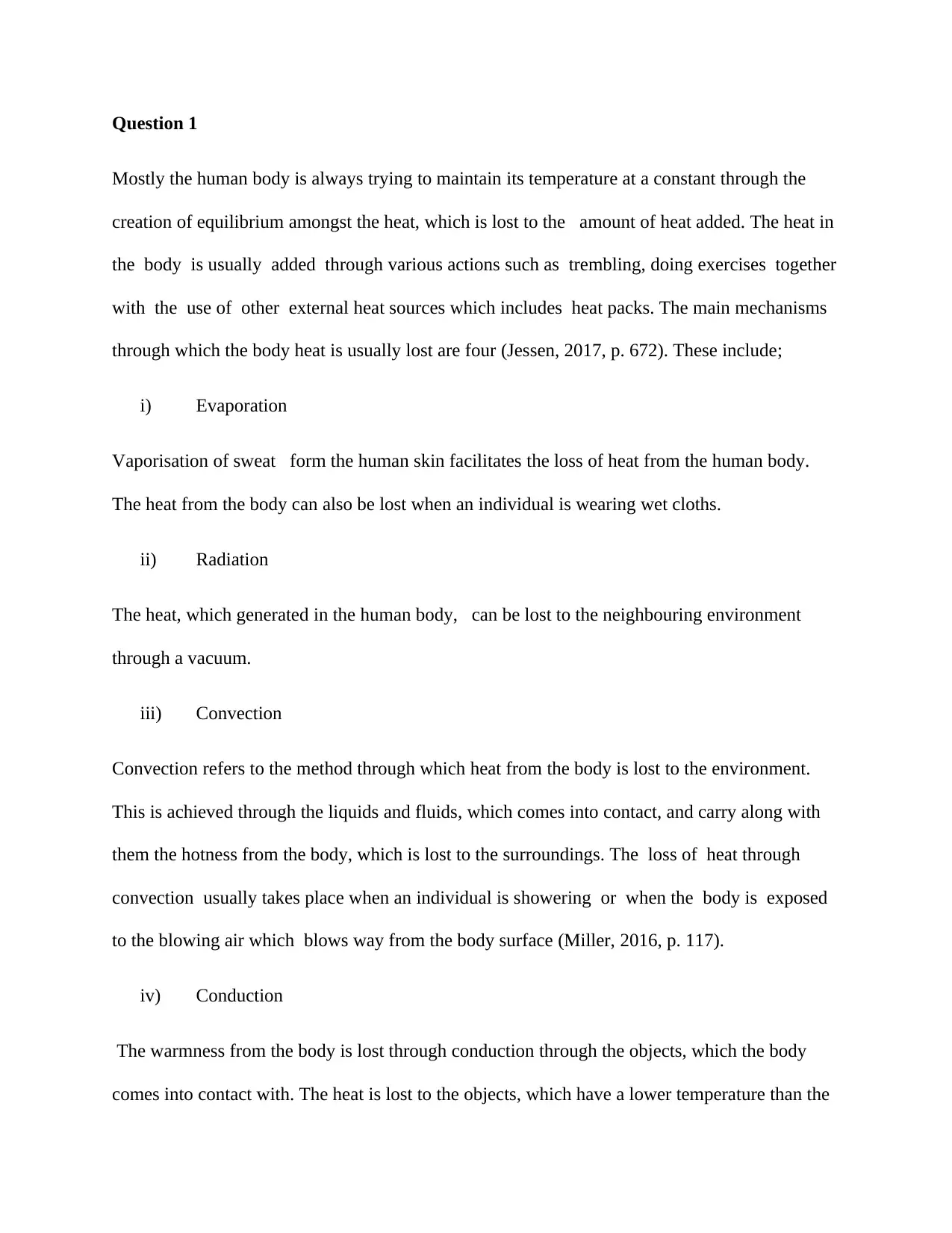
Question 1
Mostly the human body is always trying to maintain its temperature at a constant through the
creation of equilibrium amongst the heat, which is lost to the amount of heat added. The heat in
the body is usually added through various actions such as trembling, doing exercises together
with the use of other external heat sources which includes heat packs. The main mechanisms
through which the body heat is usually lost are four (Jessen, 2017, p. 672). These include;
i) Evaporation
Vaporisation of sweat form the human skin facilitates the loss of heat from the human body.
The heat from the body can also be lost when an individual is wearing wet cloths.
ii) Radiation
The heat, which generated in the human body, can be lost to the neighbouring environment
through a vacuum.
iii) Convection
Convection refers to the method through which heat from the body is lost to the environment.
This is achieved through the liquids and fluids, which comes into contact, and carry along with
them the hotness from the body, which is lost to the surroundings. The loss of heat through
convection usually takes place when an individual is showering or when the body is exposed
to the blowing air which blows way from the body surface (Miller, 2016, p. 117).
iv) Conduction
The warmness from the body is lost through conduction through the objects, which the body
comes into contact with. The heat is lost to the objects, which have a lower temperature than the
Mostly the human body is always trying to maintain its temperature at a constant through the
creation of equilibrium amongst the heat, which is lost to the amount of heat added. The heat in
the body is usually added through various actions such as trembling, doing exercises together
with the use of other external heat sources which includes heat packs. The main mechanisms
through which the body heat is usually lost are four (Jessen, 2017, p. 672). These include;
i) Evaporation
Vaporisation of sweat form the human skin facilitates the loss of heat from the human body.
The heat from the body can also be lost when an individual is wearing wet cloths.
ii) Radiation
The heat, which generated in the human body, can be lost to the neighbouring environment
through a vacuum.
iii) Convection
Convection refers to the method through which heat from the body is lost to the environment.
This is achieved through the liquids and fluids, which comes into contact, and carry along with
them the hotness from the body, which is lost to the surroundings. The loss of heat through
convection usually takes place when an individual is showering or when the body is exposed
to the blowing air which blows way from the body surface (Miller, 2016, p. 117).
iv) Conduction
The warmness from the body is lost through conduction through the objects, which the body
comes into contact with. The heat is lost to the objects, which have a lower temperature than the
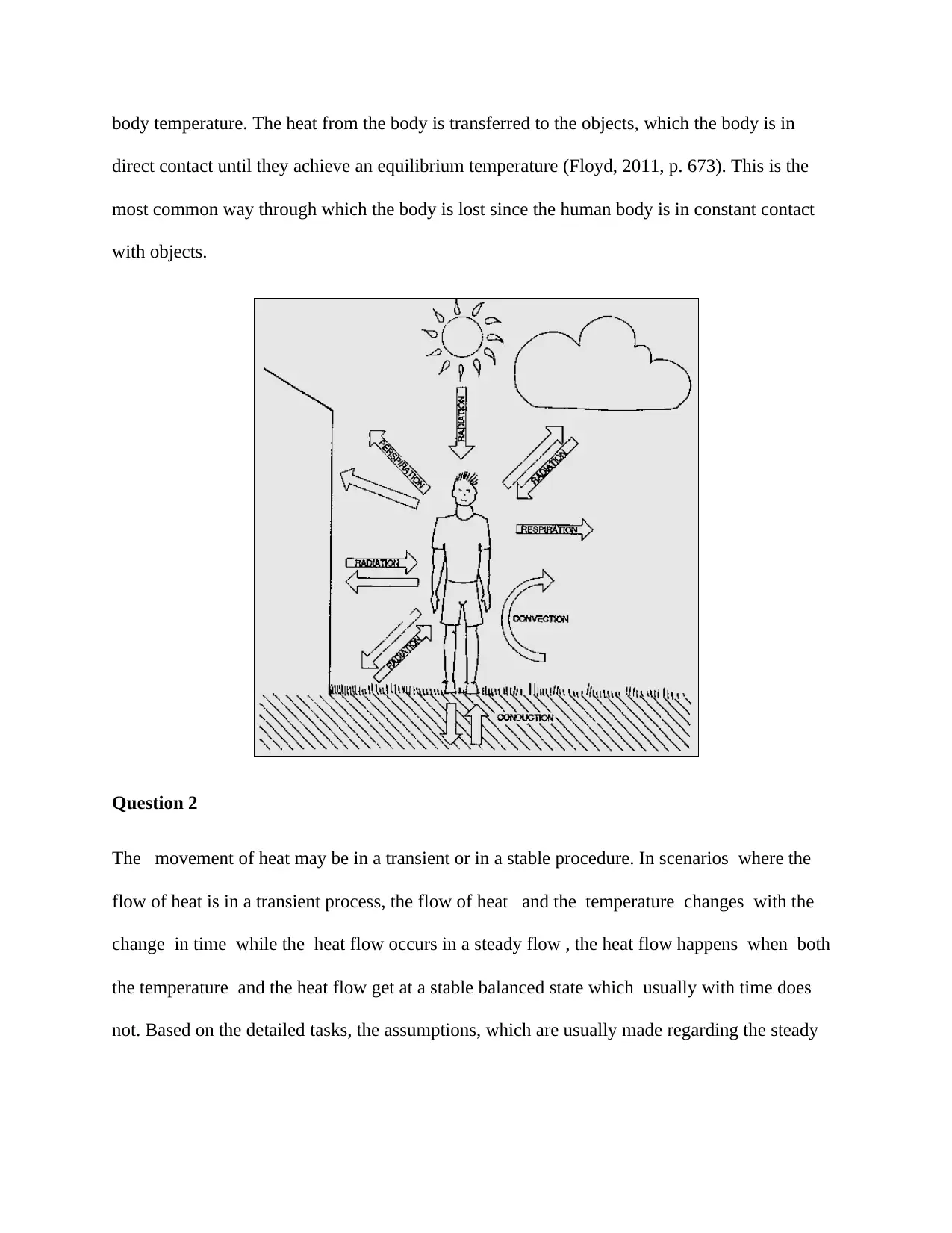
body temperature. The heat from the body is transferred to the objects, which the body is in
direct contact until they achieve an equilibrium temperature (Floyd, 2011, p. 673). This is the
most common way through which the body is lost since the human body is in constant contact
with objects.
Question 2
The movement of heat may be in a transient or in a stable procedure. In scenarios where the
flow of heat is in a transient process, the flow of heat and the temperature changes with the
change in time while the heat flow occurs in a steady flow , the heat flow happens when both
the temperature and the heat flow get at a stable balanced state which usually with time does
not. Based on the detailed tasks, the assumptions, which are usually made regarding the steady
direct contact until they achieve an equilibrium temperature (Floyd, 2011, p. 673). This is the
most common way through which the body is lost since the human body is in constant contact
with objects.
Question 2
The movement of heat may be in a transient or in a stable procedure. In scenarios where the
flow of heat is in a transient process, the flow of heat and the temperature changes with the
change in time while the heat flow occurs in a steady flow , the heat flow happens when both
the temperature and the heat flow get at a stable balanced state which usually with time does
not. Based on the detailed tasks, the assumptions, which are usually made regarding the steady
⊘ This is a preview!⊘
Do you want full access?
Subscribe today to unlock all pages.

Trusted by 1+ million students worldwide
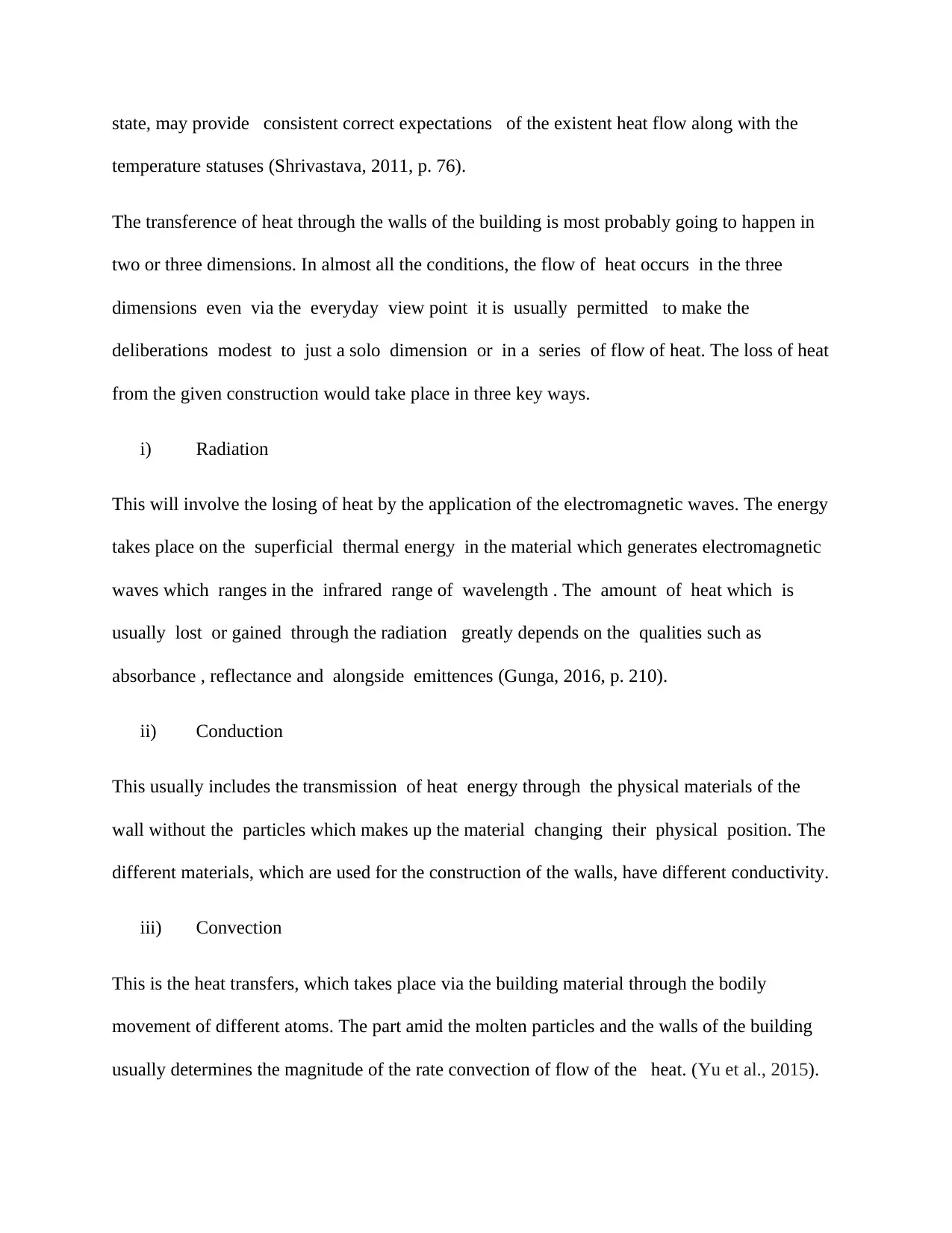
state, may provide consistent correct expectations of the existent heat flow along with the
temperature statuses (Shrivastava, 2011, p. 76).
The transference of heat through the walls of the building is most probably going to happen in
two or three dimensions. In almost all the conditions, the flow of heat occurs in the three
dimensions even via the everyday view point it is usually permitted to make the
deliberations modest to just a solo dimension or in a series of flow of heat. The loss of heat
from the given construction would take place in three key ways.
i) Radiation
This will involve the losing of heat by the application of the electromagnetic waves. The energy
takes place on the superficial thermal energy in the material which generates electromagnetic
waves which ranges in the infrared range of wavelength . The amount of heat which is
usually lost or gained through the radiation greatly depends on the qualities such as
absorbance , reflectance and alongside emittences (Gunga, 2016, p. 210).
ii) Conduction
This usually includes the transmission of heat energy through the physical materials of the
wall without the particles which makes up the material changing their physical position. The
different materials, which are used for the construction of the walls, have different conductivity.
iii) Convection
This is the heat transfers, which takes place via the building material through the bodily
movement of different atoms. The part amid the molten particles and the walls of the building
usually determines the magnitude of the rate convection of flow of the heat. (Yu et al., 2015).
temperature statuses (Shrivastava, 2011, p. 76).
The transference of heat through the walls of the building is most probably going to happen in
two or three dimensions. In almost all the conditions, the flow of heat occurs in the three
dimensions even via the everyday view point it is usually permitted to make the
deliberations modest to just a solo dimension or in a series of flow of heat. The loss of heat
from the given construction would take place in three key ways.
i) Radiation
This will involve the losing of heat by the application of the electromagnetic waves. The energy
takes place on the superficial thermal energy in the material which generates electromagnetic
waves which ranges in the infrared range of wavelength . The amount of heat which is
usually lost or gained through the radiation greatly depends on the qualities such as
absorbance , reflectance and alongside emittences (Gunga, 2016, p. 210).
ii) Conduction
This usually includes the transmission of heat energy through the physical materials of the
wall without the particles which makes up the material changing their physical position. The
different materials, which are used for the construction of the walls, have different conductivity.
iii) Convection
This is the heat transfers, which takes place via the building material through the bodily
movement of different atoms. The part amid the molten particles and the walls of the building
usually determines the magnitude of the rate convection of flow of the heat. (Yu et al., 2015).
Paraphrase This Document
Need a fresh take? Get an instant paraphrase of this document with our AI Paraphraser
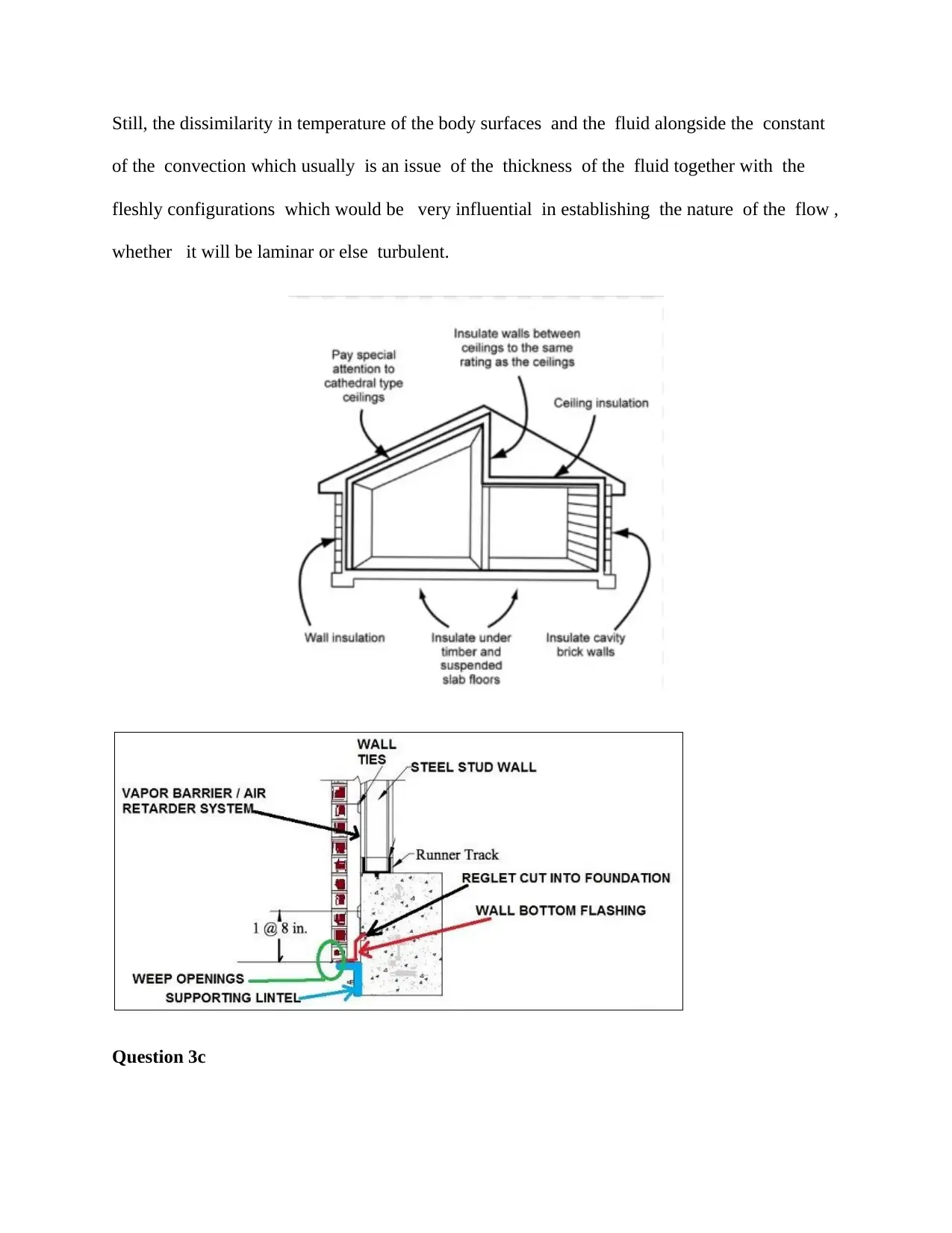
Still, the dissimilarity in temperature of the body surfaces and the fluid alongside the constant
of the convection which usually is an issue of the thickness of the fluid together with the
fleshly configurations which would be very influential in establishing the nature of the flow ,
whether it will be laminar or else turbulent.
Question 3c
of the convection which usually is an issue of the thickness of the fluid together with the
fleshly configurations which would be very influential in establishing the nature of the flow ,
whether it will be laminar or else turbulent.
Question 3c
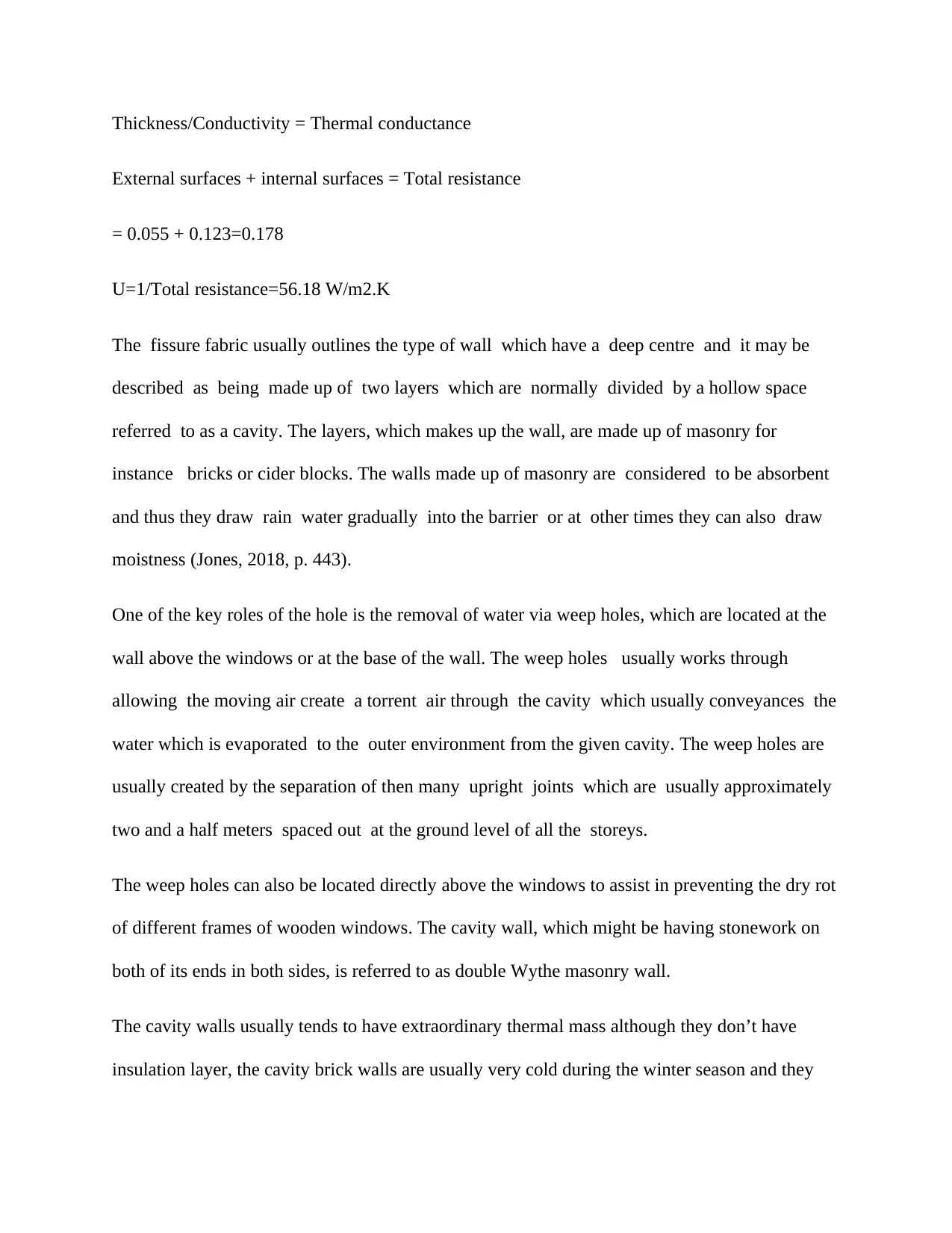
Thickness/Conductivity = Thermal conductance
External surfaces + internal surfaces = Total resistance
= 0.055 + 0.123=0.178
U=1/Total resistance=56.18 W/m2.K
The fissure fabric usually outlines the type of wall which have a deep centre and it may be
described as being made up of two layers which are normally divided by a hollow space
referred to as a cavity. The layers, which makes up the wall, are made up of masonry for
instance bricks or cider blocks. The walls made up of masonry are considered to be absorbent
and thus they draw rain water gradually into the barrier or at other times they can also draw
moistness (Jones, 2018, p. 443).
One of the key roles of the hole is the removal of water via weep holes, which are located at the
wall above the windows or at the base of the wall. The weep holes usually works through
allowing the moving air create a torrent air through the cavity which usually conveyances the
water which is evaporated to the outer environment from the given cavity. The weep holes are
usually created by the separation of then many upright joints which are usually approximately
two and a half meters spaced out at the ground level of all the storeys.
The weep holes can also be located directly above the windows to assist in preventing the dry rot
of different frames of wooden windows. The cavity wall, which might be having stonework on
both of its ends in both sides, is referred to as double Wythe masonry wall.
The cavity walls usually tends to have extraordinary thermal mass although they don’t have
insulation layer, the cavity brick walls are usually very cold during the winter season and they
External surfaces + internal surfaces = Total resistance
= 0.055 + 0.123=0.178
U=1/Total resistance=56.18 W/m2.K
The fissure fabric usually outlines the type of wall which have a deep centre and it may be
described as being made up of two layers which are normally divided by a hollow space
referred to as a cavity. The layers, which makes up the wall, are made up of masonry for
instance bricks or cider blocks. The walls made up of masonry are considered to be absorbent
and thus they draw rain water gradually into the barrier or at other times they can also draw
moistness (Jones, 2018, p. 443).
One of the key roles of the hole is the removal of water via weep holes, which are located at the
wall above the windows or at the base of the wall. The weep holes usually works through
allowing the moving air create a torrent air through the cavity which usually conveyances the
water which is evaporated to the outer environment from the given cavity. The weep holes are
usually created by the separation of then many upright joints which are usually approximately
two and a half meters spaced out at the ground level of all the storeys.
The weep holes can also be located directly above the windows to assist in preventing the dry rot
of different frames of wooden windows. The cavity wall, which might be having stonework on
both of its ends in both sides, is referred to as double Wythe masonry wall.
The cavity walls usually tends to have extraordinary thermal mass although they don’t have
insulation layer, the cavity brick walls are usually very cold during the winter season and they
⊘ This is a preview!⊘
Do you want full access?
Subscribe today to unlock all pages.

Trusted by 1+ million students worldwide
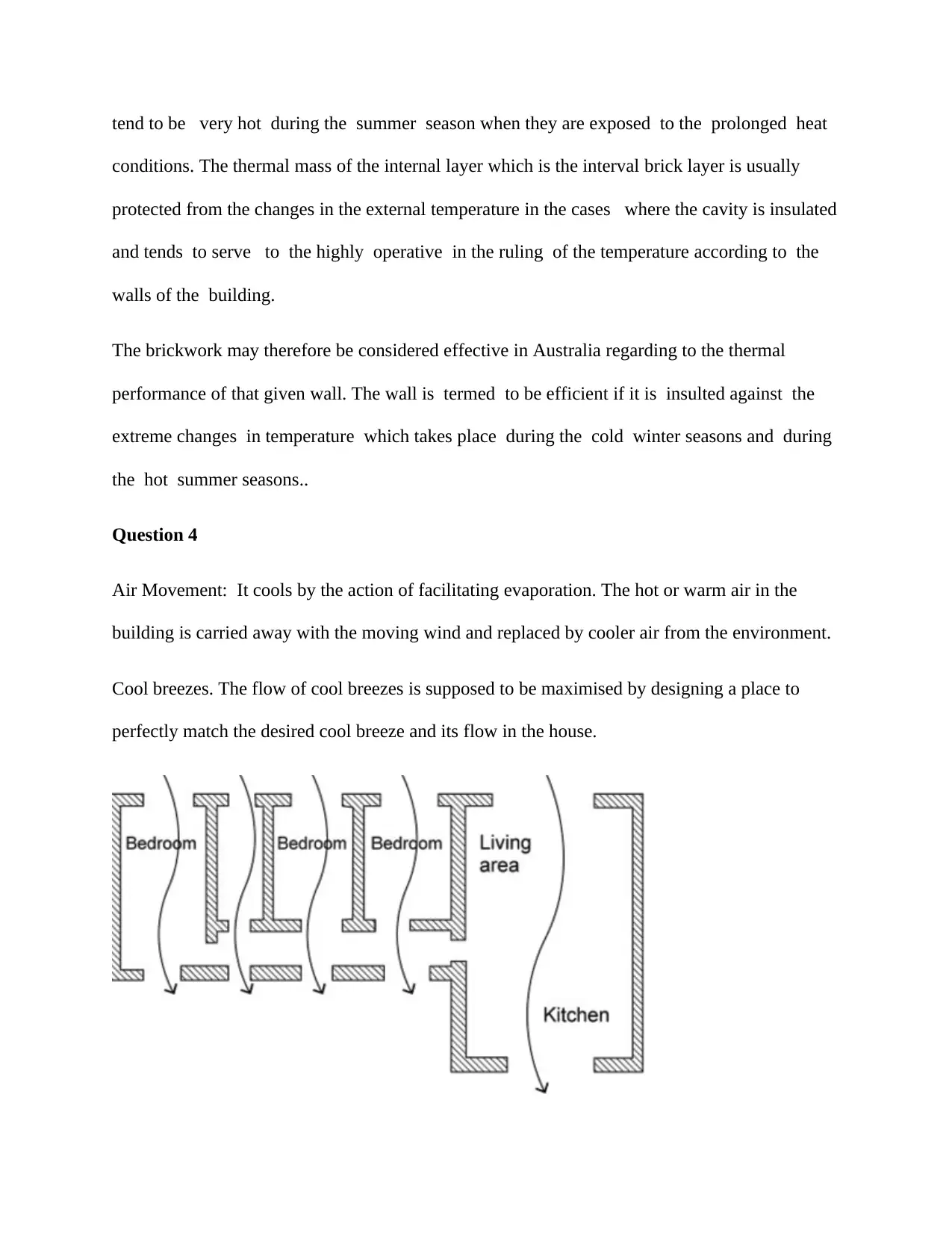
tend to be very hot during the summer season when they are exposed to the prolonged heat
conditions. The thermal mass of the internal layer which is the interval brick layer is usually
protected from the changes in the external temperature in the cases where the cavity is insulated
and tends to serve to the highly operative in the ruling of the temperature according to the
walls of the building.
The brickwork may therefore be considered effective in Australia regarding to the thermal
performance of that given wall. The wall is termed to be efficient if it is insulted against the
extreme changes in temperature which takes place during the cold winter seasons and during
the hot summer seasons..
Question 4
Air Movement: It cools by the action of facilitating evaporation. The hot or warm air in the
building is carried away with the moving wind and replaced by cooler air from the environment.
Cool breezes. The flow of cool breezes is supposed to be maximised by designing a place to
perfectly match the desired cool breeze and its flow in the house.
conditions. The thermal mass of the internal layer which is the interval brick layer is usually
protected from the changes in the external temperature in the cases where the cavity is insulated
and tends to serve to the highly operative in the ruling of the temperature according to the
walls of the building.
The brickwork may therefore be considered effective in Australia regarding to the thermal
performance of that given wall. The wall is termed to be efficient if it is insulted against the
extreme changes in temperature which takes place during the cold winter seasons and during
the hot summer seasons..
Question 4
Air Movement: It cools by the action of facilitating evaporation. The hot or warm air in the
building is carried away with the moving wind and replaced by cooler air from the environment.
Cool breezes. The flow of cool breezes is supposed to be maximised by designing a place to
perfectly match the desired cool breeze and its flow in the house.
Paraphrase This Document
Need a fresh take? Get an instant paraphrase of this document with our AI Paraphraser
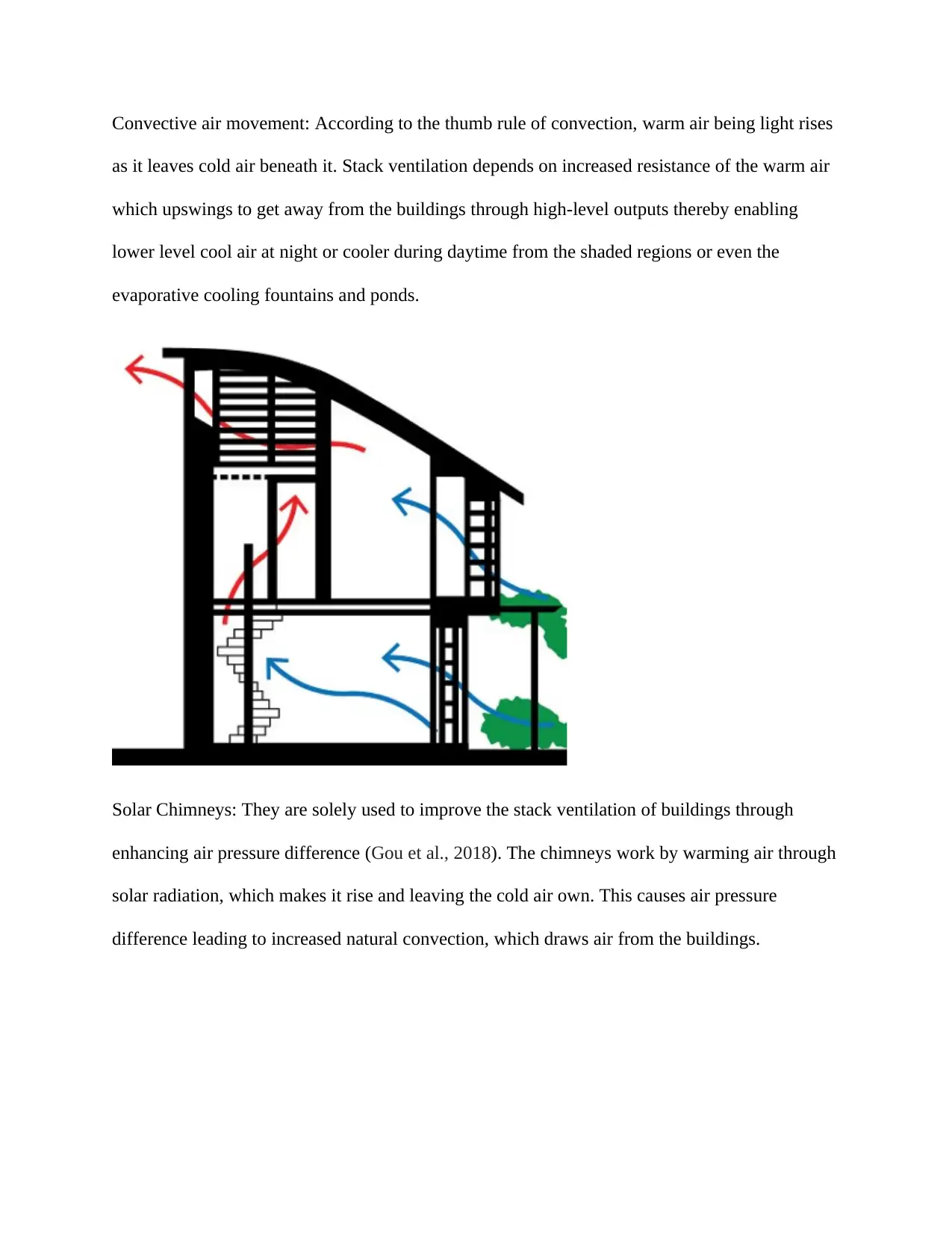
Convective air movement: According to the thumb rule of convection, warm air being light rises
as it leaves cold air beneath it. Stack ventilation depends on increased resistance of the warm air
which upswings to get away from the buildings through high-level outputs thereby enabling
lower level cool air at night or cooler during daytime from the shaded regions or even the
evaporative cooling fountains and ponds.
Solar Chimneys: They are solely used to improve the stack ventilation of buildings through
enhancing air pressure difference (Gou et al., 2018). The chimneys work by warming air through
solar radiation, which makes it rise and leaving the cold air own. This causes air pressure
difference leading to increased natural convection, which draws air from the buildings.
as it leaves cold air beneath it. Stack ventilation depends on increased resistance of the warm air
which upswings to get away from the buildings through high-level outputs thereby enabling
lower level cool air at night or cooler during daytime from the shaded regions or even the
evaporative cooling fountains and ponds.
Solar Chimneys: They are solely used to improve the stack ventilation of buildings through
enhancing air pressure difference (Gou et al., 2018). The chimneys work by warming air through
solar radiation, which makes it rise and leaving the cold air own. This causes air pressure
difference leading to increased natural convection, which draws air from the buildings.
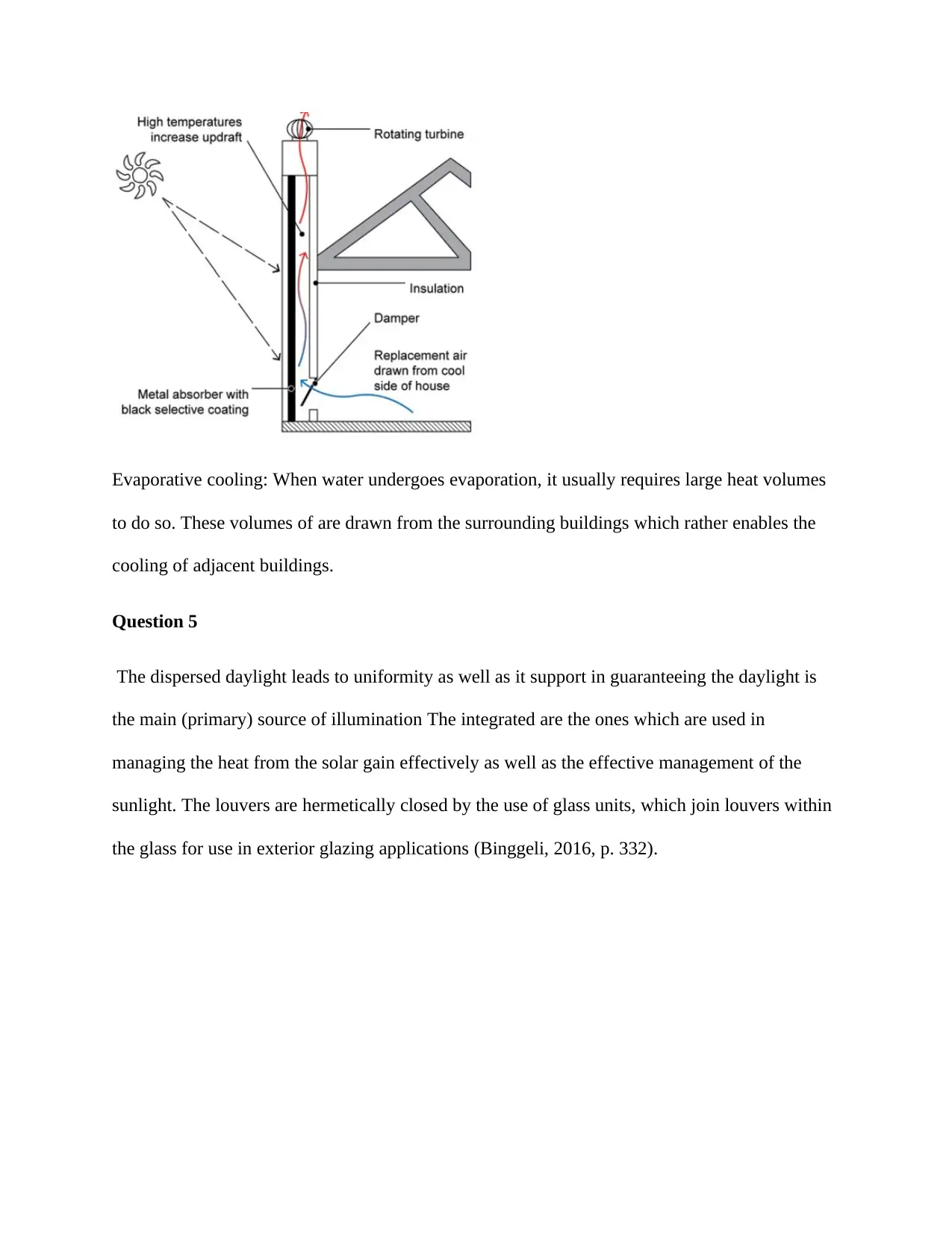
Evaporative cooling: When water undergoes evaporation, it usually requires large heat volumes
to do so. These volumes of are drawn from the surrounding buildings which rather enables the
cooling of adjacent buildings.
Question 5
The dispersed daylight leads to uniformity as well as it support in guaranteeing the daylight is
the main (primary) source of illumination The integrated are the ones which are used in
managing the heat from the solar gain effectively as well as the effective management of the
sunlight. The louvers are hermetically closed by the use of glass units, which join louvers within
the glass for use in exterior glazing applications (Binggeli, 2016, p. 332).
to do so. These volumes of are drawn from the surrounding buildings which rather enables the
cooling of adjacent buildings.
Question 5
The dispersed daylight leads to uniformity as well as it support in guaranteeing the daylight is
the main (primary) source of illumination The integrated are the ones which are used in
managing the heat from the solar gain effectively as well as the effective management of the
sunlight. The louvers are hermetically closed by the use of glass units, which join louvers within
the glass for use in exterior glazing applications (Binggeli, 2016, p. 332).
⊘ This is a preview!⊘
Do you want full access?
Subscribe today to unlock all pages.

Trusted by 1+ million students worldwide
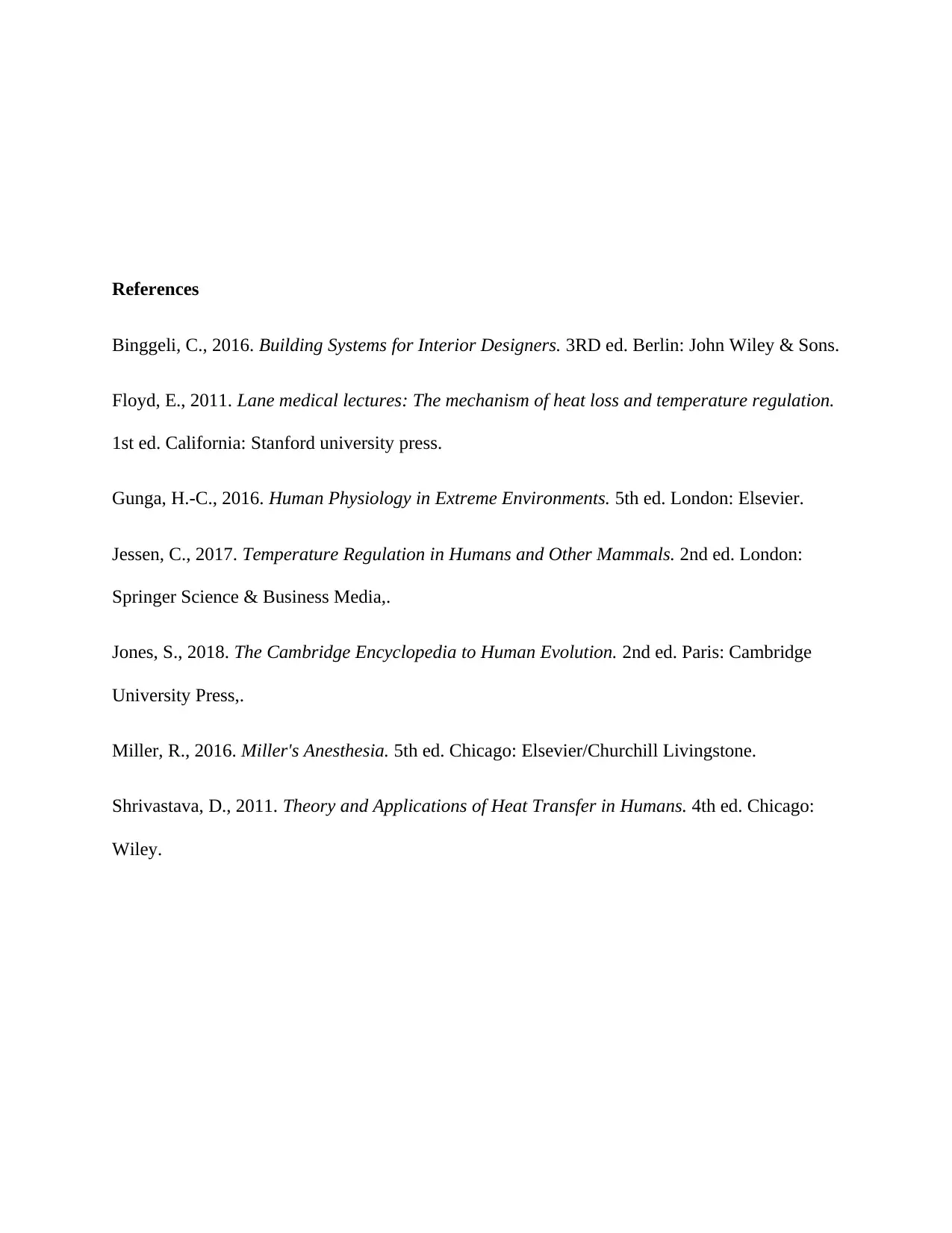
References
Binggeli, C., 2016. Building Systems for Interior Designers. 3RD ed. Berlin: John Wiley & Sons.
Floyd, E., 2011. Lane medical lectures: The mechanism of heat loss and temperature regulation.
1st ed. California: Stanford university press.
Gunga, H.-C., 2016. Human Physiology in Extreme Environments. 5th ed. London: Elsevier.
Jessen, C., 2017. Temperature Regulation in Humans and Other Mammals. 2nd ed. London:
Springer Science & Business Media,.
Jones, S., 2018. The Cambridge Encyclopedia to Human Evolution. 2nd ed. Paris: Cambridge
University Press,.
Miller, R., 2016. Miller's Anesthesia. 5th ed. Chicago: Elsevier/Churchill Livingstone.
Shrivastava, D., 2011. Theory and Applications of Heat Transfer in Humans. 4th ed. Chicago:
Wiley.
Binggeli, C., 2016. Building Systems for Interior Designers. 3RD ed. Berlin: John Wiley & Sons.
Floyd, E., 2011. Lane medical lectures: The mechanism of heat loss and temperature regulation.
1st ed. California: Stanford university press.
Gunga, H.-C., 2016. Human Physiology in Extreme Environments. 5th ed. London: Elsevier.
Jessen, C., 2017. Temperature Regulation in Humans and Other Mammals. 2nd ed. London:
Springer Science & Business Media,.
Jones, S., 2018. The Cambridge Encyclopedia to Human Evolution. 2nd ed. Paris: Cambridge
University Press,.
Miller, R., 2016. Miller's Anesthesia. 5th ed. Chicago: Elsevier/Churchill Livingstone.
Shrivastava, D., 2011. Theory and Applications of Heat Transfer in Humans. 4th ed. Chicago:
Wiley.
1 out of 10
Related Documents
Your All-in-One AI-Powered Toolkit for Academic Success.
+13062052269
info@desklib.com
Available 24*7 on WhatsApp / Email
![[object Object]](/_next/static/media/star-bottom.7253800d.svg)
Unlock your academic potential
Copyright © 2020–2025 A2Z Services. All Rights Reserved. Developed and managed by ZUCOL.





